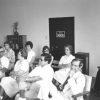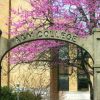calsfoundation@cals.org
Alonzo Warren Ashley (1936–2019)
Alonzo Warren Ashley was a pioneer in the effort to attract African Americans and other minorities to STEM (science, technology, engineering, mathematics) fields in education, especially in higher education. After retiring from a three-decade-long career at Stanford University, he and his new wife, Wanda Ashley, a Little Rock (Pulaski County) resident whom he had met at a conference and married in 1999, settled in Little Rock. In 2004, he co-founded the Arkansas Mentoring and Networking Association.
Alonzo Warren Ashley was born on March 13, 1936, in Tuskegee, Alabama, the youngest of four children of Alonzo Ray Ashley and Beatrice Hyde Ashley. Ashley’s father was a well-read man who was seldom without a book. He worked at the Veterans Affairs hospital for forty-one years, initially as a janitor. Ashley’s mother taught private piano lessons and was a substitute music teacher at the local high school.
Ashley grew up in Tuskegee. As Ashley recalled, “In those days the place to live in the South was Tuskegee. It had three things going for it: There was the Tuskegee Institute…they had the Tuskegee Airmen, and they had the third largest VA hospital in the United States.” Ashley earned a bachelor’s degree from Texas Southern University in Houston, and then got a job at the Westside Veterans Administration Hospital in Buffalo, New York. After the hospital sent him to a conference in Santa Monica, California, he determined that he would not return to snowy Buffalo. He soon got a job as an assistant director of recreation and parks for the city of Los Angeles.
In 1968, one of his supervisors with the Parks Department recommended him for a job at Stanford University and urged him to interview. While Ashley acknowledged that he knew nothing about Stanford, when he called his father, he was informed that it was “a major university. It’s the Harvard of the West.” The interview at Stanford led to him being hired as minority representative for employment and training at the Stanford Linear Accelerator Center, now the SLAC National Accelerator Laboratory. It was from there that he launched the programs that would become his legacy. Through his work in employee relations and employment training at Stanford, he quickly realized that it was, in his words “the scientists [who] were the high and mighty, they were the last word at the laboratory and they were the most powerful people—the scientists, the physicists, the engineers—and I didn’t see many minorities in those roles.” He understood that “if our kids were going to be involved in something in the 21st century then they had to be involved in science and technology because science and technology was the wave of the future.”
Supported by a Stanford administration that recognized the racial imbalance that characterized both their own campus and the STEM fields in general, beginning in 1969, Ashley set out to visit many of the nation’s historically Black colleges and universities (HBCUs). He met with deans and made them aware of opportunities available for their students at Stanford’s labs. He not only urged the deans to visit, but he invited six professors—including one who was Native American and one who was Hispanic—to come to campus for an all-expenses-paid, ten-week fellowship.
In 1970, he was named the employee relations representative for SLAC; in 1983, he became personnel officer for the organization’s employee relations. That same year, following up on his visits with the HBCUs, Ashley created the SLAC Summer Science Research Program for under-represented minority-group undergraduates in STEM studies, which allowed minority college students to spend nine weeks on campus, attending classes and getting hands-on experience in the laboratories. He recalled that the program got a lot of publicity and was well-received throughout the nation, and the program was soon able to bring twenty-five students to live at Stanford and participate in the program with all expenses covered.
Along the way, he earned a master’s degree in public administration from California State University in Hayward. In addition to the formal programs he initiated and developed, he was a mentor and networker, identifying students and opportunities and building solid connections between them.
Typical was the case of Jonathan Evans, a nuclear engineer with the U.S. Nuclear Regulatory Commission. Ashley mentored Evans for years, helping him secure internships at the University of Texas Medical Branch in Galveston, while also helping him get internships at the Nuclear Regulatory Commission and at Harvard and Yale.
While he retired from Stanford in 1999, Ashley remained a consultant at the university as well as for the National Oceanic and Atmospheric Administration, the National Institute of Standards and Technology, and the National Consortium for Graduate Degrees for Minorities (GEM) in Engineering and Science. In 2004, he co-founded the Arkansas Mentoring and Networking Association and continued his mentoring efforts until his death.
He was recognized by the National Society of Black Physicists as the subject of a resolution signed by Nobel laureates as well as a proclamation signed by administrators of the Atlanta University Center Incorporation and the Dual Degree Engineering Program. In 2005, Ashley was awarded the Presidential Award for Excellence in Science, Mathematics and Engineering Mentoring from the National Science Foundation. That award, established by the White House in 1985, not only recognized him as someone who “mentored individuals underrepresented in STEM education and in the workforce,” but also garnered a $10,000 award for Stanford’s Linear Acceleration Center, where Ashley’s efforts had begun. Upon his retirement from Stanford, the university established the Alonzo W. Ashley Fellowship Program, which provided one-year fellowships for groups underrepresented in STEM fields.
Ashley, who served as a private first class in the U.S. Army and was stationed in Korea, died on October 4, 2019. He is buried in the Arkansas State Veterans Cemetery in North Little Rock (Pulaski County).
For additional information:
Dishongh, Kimberly. “Alonzo Warren Ashley.” Arkansas Democrat-Gazette, February 18, 2018, pp. 1D, 5D. Online at https://www.arkansasonline.com/news/2018/feb/18/alonzo-warren-ashley/ (accessed May 7, 2025).
“Q&A: Al Ashley Reflects on His Efforts to Diversify SLAC and Beyond.” SLAC National Accelerator Laboratory, March 14, 2018. https://www6.slac.stanford.edu/news/2018-03-14-qa-al-ashley-reflects-his-efforts-diversify-slac-and-beyond (accessed May 7, 2025).
Simpson, Stephen. “Physicist Was Guide for Many Students.” Arkansas Democrat-Gazette, October 8, 2019, p. 4B. Online at https://www.arkansasonline.com/news/2019/oct/08/alonzo-warren-ashley-20191008/ (accessed May 7, 2025).
William H. Pruden III
Ravenscroft School
 Divergent Prosperity and the Arc of Reform, 1968–2022
Divergent Prosperity and the Arc of Reform, 1968–2022 Education, Higher
Education, Higher



Comments
No comments on this entry yet.